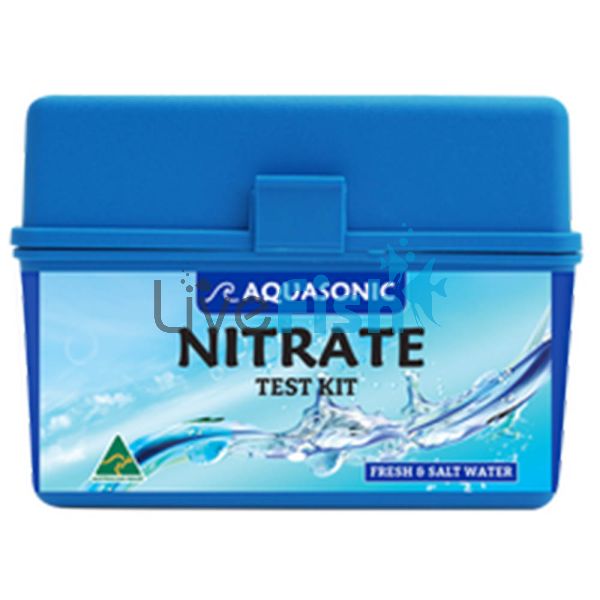Aquasonic Nitrate Test Kit
In all aquarium systems, biological activity develops in your filter, and on the surface of gravels and decorations, etc. These bacteria are essential to achieve a balance in your aquarium and different types of bacteria need to be present in the right proportions to break down waste and deal with ammonia, nitrite, and nitrate, which can all be harmful to your fish. Every time you change or add something to your tank or you clean it, you potentially upset the balance because you are effectively removing some of these bacteria.
NITRATE TEST KIT
In all aquarium systems, biological activity develops in your filter, and on the surface of gravels and decorations, etc. These bacteria are essential to achieve a balance in your aquarium and different types of bacteria need to be present in the right proportions to break down waste and deal with ammonia, nitrite, and nitrate, which can all be harmful to your fish. Every time you change or add something to your tank or you clean it, you potentially upset the balance because you are effectively removing some of these bacteria.
NITRATE
Nitrate ions are produced as a result of biological action occurring mainly in your aquarium filter system. It is the residue of a chain reaction by aerobics bacteria, breaking down fish waste. Nitrate accumulates in an aquarium in proportion to the stock load waste and is a good indicator of general water quality.
PERMISSIBLE NITRATE LEVELS
As nitrate levels increase, water quality decreases. The quantity of permissible nitrate varies with the particular aquatic life being cultured.
PERMISSIBLE NITRATE LEVELS
As nitrate levels increase, water quality decreases. The quantity of permissible nitrate varies with the particular aquatic life being cultured.
- For marine systems culturing fish, acceptable levels are 20ppm to 40ppm. Many species of marine fish will accept higher levels of 80ppm to 100ppm without apparent effect on their health. But it is recommended that when levels climb above 40ppm steps should be taken to lower the nitrate to avoid stress.
- For reef systems culturing invertebrates, much lower levels of nitrate are acceptable. A level of 5ppm or less is optimum. Again, many invertebrates will accept higher levels but once these levels climb above 20ppm many of the more sensitive invertebrates will be irreparably damaged. It has been shown that small quantities of around 5ppm of nitrate are of assistance in culturing marine plants. Nitrate tests on reef systems should occur weekly and levels should be kept below 10ppm.
- Freshwater fish. Tolerance to nitrate in freshwater fish is higher than in saltwater species. Some delicate species will tolerate around 50ppm, but some species will tolerate far higher levels. It is recommended that as nitrate levels approach 50ppm steps should be taken to reduce the level.
LOWERING NITRATE
The easiest method to lower nitrate is to change the water. Regular water changes should ensure that the nitrate levels stay within acceptable limits. Recommended minimum water change requirements are 25% per month. If water changes do not keep the nitrate at acceptable levels, then perhaps the number of fish in the tank is too great for your aquarium system, so reduce the number of fish. Denitrification filters can lower nitrate successfully, but this must be closely monitored to avoid dangerous gases that can harm aquarium inhabitants. Marine plants and algae can use some nitrate as nutrients and are a definite advantage in the control of nitrate.
TO BREAK THE AMMONIA->NITRITE->NITRATE CYCLE:
- Perform a water change.
- Remove anything that can cause ammonia to form (e.g., dead organic matter or excess fish waste) from amongst the substrate (e.g., gravel cleaner)
- Use Aquasonic AMMO-GONE to neutralize the ammonia in the system.
The manual addition of live strains of nitrifying bacteria can also aid in kick-starting the biological activity in the filter system.
DIRECTIONS FOR USE:
To determine the Nitrate level in water:
- Rinse the empty test tube and cap it several times in the water to be tested.
- Fill the test tube to the 5ml mark and add 7 drops of Reagent A. Swirl to mix.
- Add 1 level scoop of Reagent B, and gently swirl the solution for a few seconds. Ensure that Reagent B is kept dry at all times.
- Add 7 drops of Reagent C, mix for a few seconds and let the solution stand for 3 minutes after which time full colour development will have occurred.
- Place the test tube on the white background of the colour chart, and view it vertically down the tube. The colour in the test tube is best viewed with natural light behind you.
- On completion of the test, rinse and clean the test tube. Ensure Reagent B remains dry and that the cap is firmly in place.
NOTE: If the nitrate level in the test solution is more than 80ppm (the colour would be darker than that shown on the chart) then you can still determine the level by diluting the sample with nitrate-free water (preferably distilled water). For example, to prepare a test that will measure up to 160ppm nitrate, mix a sample with half water to be tested and half water that is nitrate free. Then multiply the results of the test by 2. To read up to 320ppm nitrate, use 25% water to be tested and 75% nitrate-free water, then multiply the result by 4.
*This colour chart provides a basic guide only. Colours may vary according to various water conditions.
SAFETY DIRECTIONS
- Keep out of reach of children.
- Reagents in this test kit could be harmful if swallowed.
- Avoid contact with the skin. If contact does occur, wash with soap and water. To avoid soap contamination with aquaria, rinse your hands thoroughly.
- Reagents A and C contain dilute acetic acid.
- Reagent B contains powdered zinc.
| Scientific Name | Test Kit |
|---|




